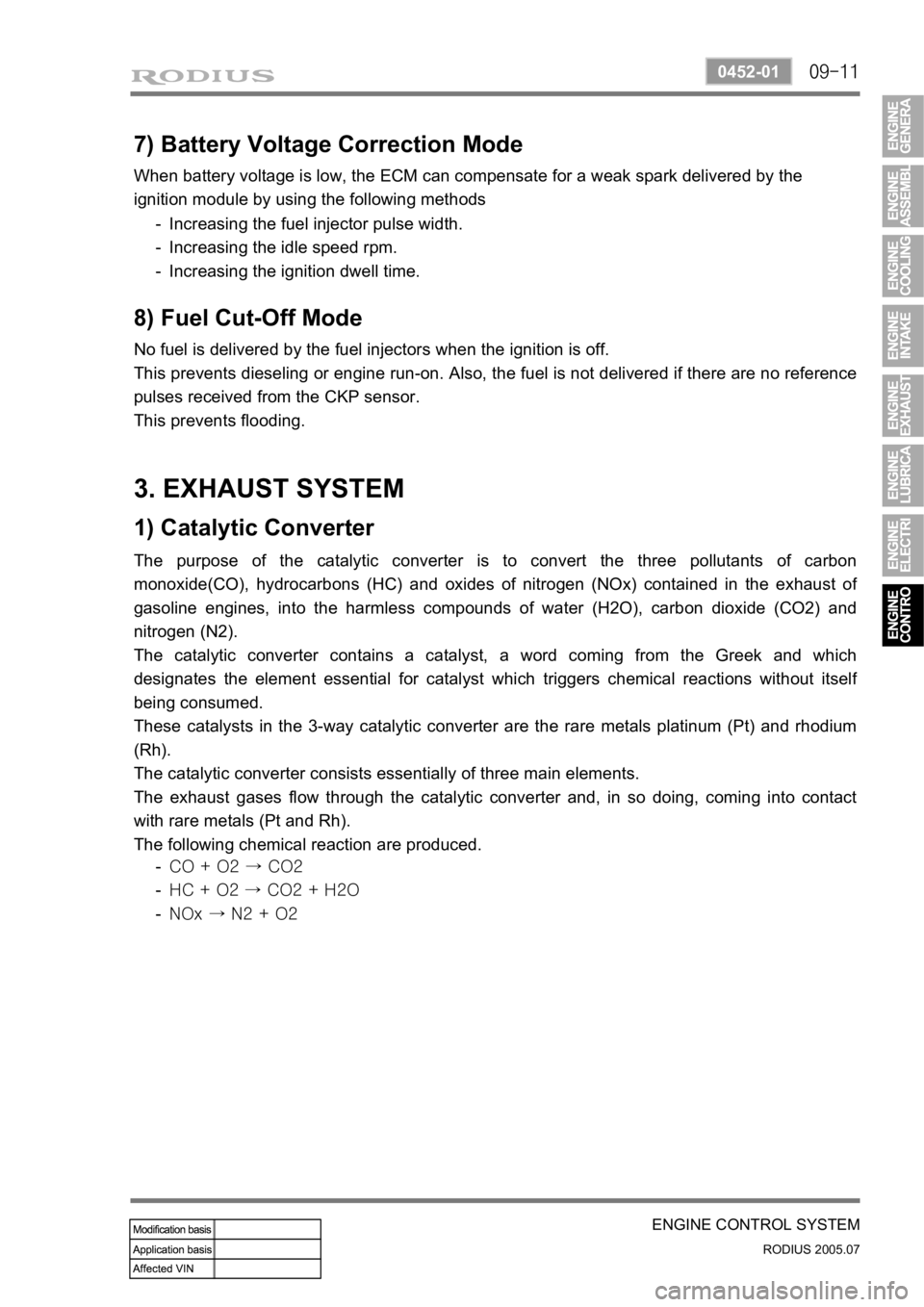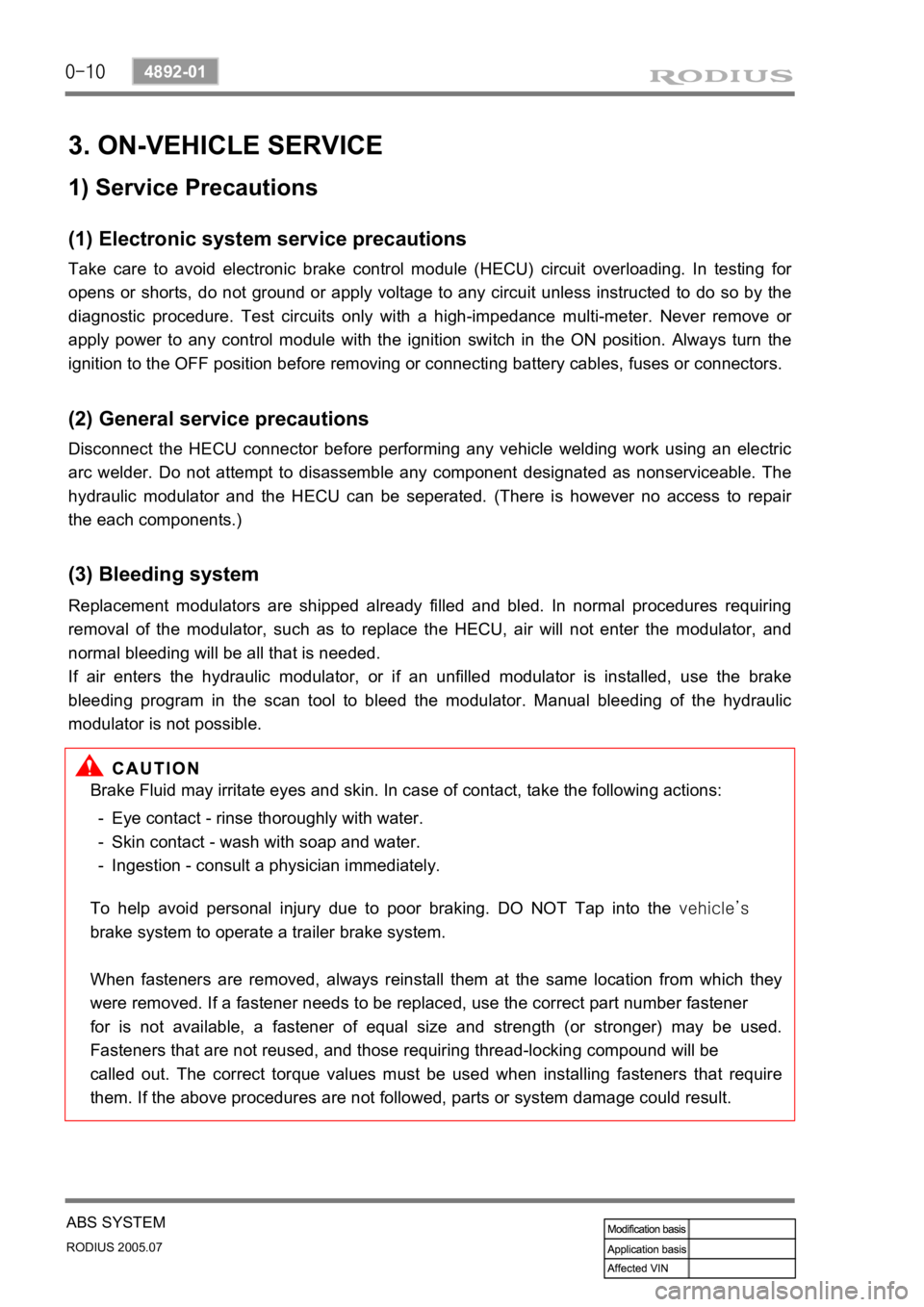Page 157 of 502

09-11
ENGINE CONTROL SYSTEM
RODIUS 2005.07
0452-01
No fuel is delivered by the fuel injectors when the ignition is off.
This prevents dieseling or engine run-on. Also, the fuel is not delivered if there are no reference
pulses received from the CKP sensor.
This prevents flooding.
8) Fuel Cut-Off Mode
Increasing the fuel injector pulse width.
Increasing the idle speed rpm.
Increasing the ignition dwell time. -
-
- When battery voltage is low, the ECM can compensate for a weak spark delivered by the
ignition module by using the following methods
7) Battery Voltage Correction Mode
3. EXHAUST SYSTEM
1) Catalytic Converter
The purpose of the catalytic converter is to convert the three pollutants of carbon
monoxide(CO), hydrocarbons (HC) and oxides of nitrogen (NOx) contained in the exhaust o
f
gasoline engines, into the harmless compounds of water (H2O), carbon dioxide (CO2) and
nitrogen (N2).
The catalytic converter contains a catalyst, a word coming from the Greek and which
designates the element essential for catalyst which triggers chemical reactions without itsel
f
being consumed.
These catalysts in the 3-way catalytic converter are the rare metals platinum (Pt) and rhodium
(Rh).
The catalytic converter consists essentially of three main elements.
The exhaust gases flow through the catalytic converter and, in so doing, coming into contact
with rare metals (Pt and Rh).
The following chemical reaction are produced.
CO + O2 → CO2
HC + O2 → CO2 + H2O
NOx → N2 + O2 -
-
-
Page 262 of 502

0-10
RODIUS 2005.07
4892-01
ABS SYSTEM
3. ON-VEHICLE SERVICE
(1) Electronic system service precautions
Take care to avoid electronic brake control module (HECU) circuit overloading. In testing for
opens or shorts, do not ground or apply voltage to any circuit unless instructed to do so by the
diagnostic procedure. Test circuits only with a high-impedance multi-meter. Never remove o
r
apply power to any control module with the ignition switch in the ON position. Always turn the
ignition to the OFF position before removing or connecting battery cables, fuses or connectors.
(2) General service precautions
Disconnect the HECU connector before performing any vehicle welding work using an electric
arc welder. Do not attempt to disassemble any component designated as nonserviceable. The
hydraulic modulator and the HECU can be seperated. (There is however no access to repai
r
the each components.)
(3) Bleeding system
Replacement modulators are shipped already filled and bled. In normal procedures requiring
removal of the modulator, such as to replace the HECU, air will not enter the modulator, and
normal bleeding will be all that is needed.
If air enters the hydraulic modulator, or if an unfilled modulator is installed, use the brake
bleeding program in the scan tool to bleed the modulator. Manual bleeding of the hydraulic
modulator is not possible.
1) Service Precautions
Brake Fluid may irritate eyes and skin. In case of contact, take the following actions:
Eye contact - rinse thoroughly with water.
Skin contact - wash with soap and water.
Ingestion - consult a physician immediately. -
-
-
To help avoid personal injury due to poor braking. DO NOT Tap into the vehicle’s
brake system to operate a trailer brake system.
When fasteners are removed, always reinstall them at the same location from which they
were removed. If a fastener needs to be replaced, use the correct part number fastener
for is not available, a fastener of equal size and strength (or stronger) may be used.
Fasteners that are not reused, and those requiring thread-locking compound will be
called out. The correct torque values must be used when installing fasteners that require
them. If the above procedures are not followed, parts or system damage could result.
Page 318 of 502
0-5
STICS
RODIUS 2005.07
8710-01
The STICS in this vehicle has similar functions with the one used in the new Rexton. Additional
function of diagnosing through SCAN-Tool has been added into new STICS.
The major difference in hardware-wise is that STICS receives vehicle collision signal from G-
sensor in the airbag module to activate automatic door unlock function when the vehicle
collided over 15 km/h of vehicle speed.
1. COMPONENTS LOCATOR
STICS / ICM module
Air bag ECU
Sends the vehicle collision
signals to STICS.
Theft deterrent horn
Installed under the battery. This
horn works only for the theft
deterrent function, panic
function, and remote starting.
SCAN-tool
SCAN-100 is used fo
r
REKES key coding and
trouble diagnosis.
REKES
Added the escort and
panic function
RK STICS
ICM module
This module contains
various relays, chime and
buzzer controlled by
STICS
Page 338 of 502

0-25
STICS
RODIUS 2005.07
8710-01
9) Battery Saver (Tail Lamp Auto Cut)
The tail lamp is turn on or off according to the operations of the multifunction tail lamp switch.
<007b008f008c0047009b0088009000930047009300880094009700470099008c0093008800a000470090009a0047009b009c00990095008c008b00470096008d008d0047004f0088009c009b00960047008a009c009b00500047009e008f008c0095004700
960097008c009500900095008e004700880095008b0047008a>losing the driver’s door
after removing the ignition key without turning off the tail lamp.
Tail lamp relay is turned on when inserting the ignition key into ignition switch again after
step 2 operation.
<007b008f008c0047009b0088009000930047009300880094009700470099008c0093008800a000470090009a0047009b009c00990095008c008b00470096008d008d0047004f0088009c009b00960047008a009c009b00500047009e008f008c0095004700
960097008c009500900095008e004700880095008b0047008a>losing the driver’s door
while the ignition key is removed and the tail lamp is turned on. 1.
2.
3.
4.
Page 341 of 502

0-28
RODIUS 2005.07
8710-01
STICS
11) Door LOCK/UNLOCK Control
(1) Door Lock/Unlock by Door Lock Switch
The door lock system outputs “LOCK” for 0.5 seconds (T1) when positioning the
driver’s or passenger’s door lock switch to lock position (while the driver’s and
passenger’s door lock switch is in “UNLOCK” position).
The door lock system outputs “UNLOCK” for 0.5 seconds (T2) when positioning the
driver’s or passenger’s door lock switch to unlock position.
“LOCK” or “UNLOCK” by the door lock switch is ignored when outputting the “LOCK”
or “UNLOCK” by other functions.
The door lock/unlock system is not working regardless of the door lock switch positions
when connecting the battery.
All door lock signals are “UNLOCK” for 0.5 seconds (T4) just for once when receiving
the “LOCK” signal within 0.5 seconds (T3) after closing the driver’s or
passenger’s
door. However, this operation is regardless of the ignition key positions. 1.
2.
3.
4.
5.
This function prevents the door from locking by shock when slamming a door while the
ignition key is inserted into the key switch hole. -
Page 356 of 502
0-4
RODIUS 2005.07
8010-10
CLUSTER
2. DESCRIPTIONS OF INDICATOR DISPLAY
1. Immobilizer indicator
2. Glow indicator
3. Winter mode indicator
4. Left turn signal indicator
5. Auto shift indicator (for automatic transmission)
6. Right turn signal indicator
7. Harzard indicator*
8. Engine check warning light
9. Cruise control indicator*
10. 4WD CHECK warning light
11. 4WD HIGH indicator
12. 4WD LOW indicator
13. Brake warning light14. Battery charge warning light
15. Seat belt reminder
16. Low fuel level warning light
17. Heated glass indicator
18. Door open warning light
19. High beam indicator
20. Engine oil pressure warning light
21. Air bag warning light
22. Water separator warning light
23. ABS warning light
24. EBD warning light
25. ESP warning light
Page 403 of 502
0-13
PARKING AID SYSTEM
RODIUS 2005.07
8790-04
3) Rearview Camera Operation
The reverse signal works as an operation signal for rearview camera. If it receives reverse
signal, the rearview camera is turned on even though the AV unit is turned off.
The rearview camera consists of AV unit (including monitor), reverse signal, battery voltage and
rearview camera.
The AV unit receives the power from battery and if it receives the reverse signal, supplies the
power to rearview camera.
When the rearview camera operates, it transmits color video signal to the A/V unit then the
rearview is displayed on the monitor.
Page 468 of 502
0-21
SEAT
RODIUS 2005.07
7410-01
3) Seat electrical equipment check
Disconnect the seat wiring connector and check if the power is supplied (Refer to the wiring
diagram)
·
1) If the power supply has no problem, remove the seat.
2) Check the motor and wiring if damaged.
3) Connect the battery to the seat connector.
4) Control the seat switch and check the opration.
- Electrical parts are not supplied by a part separately.